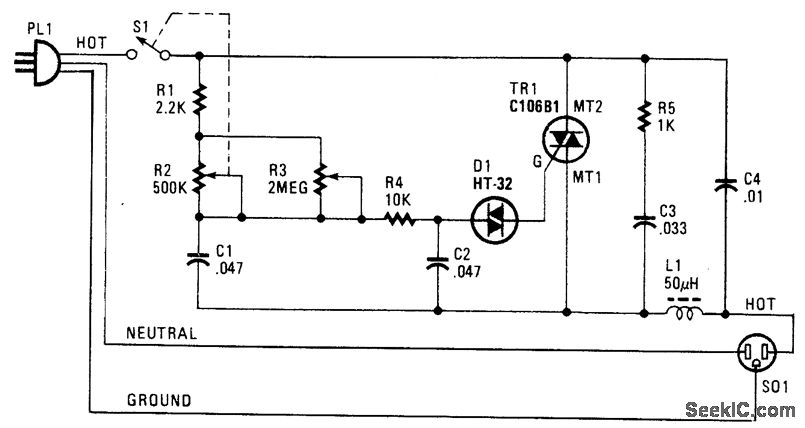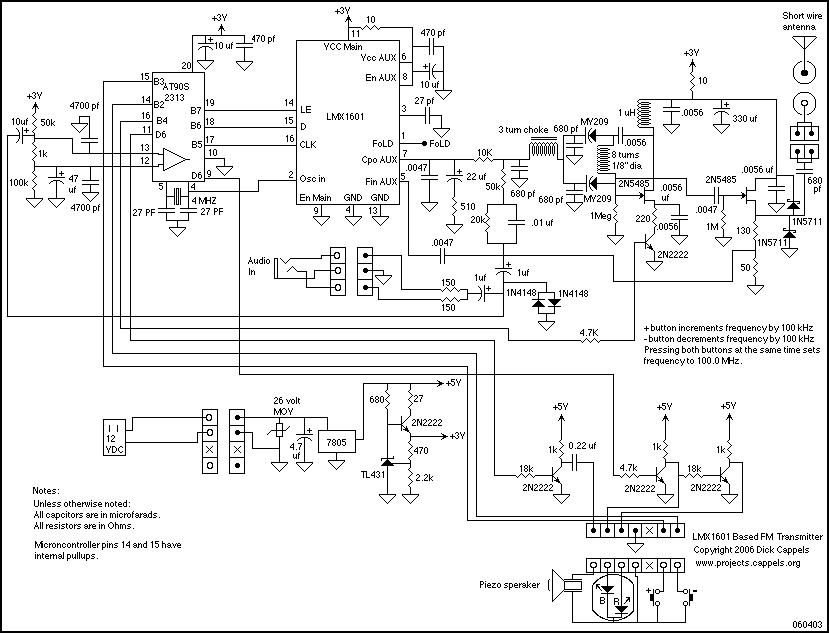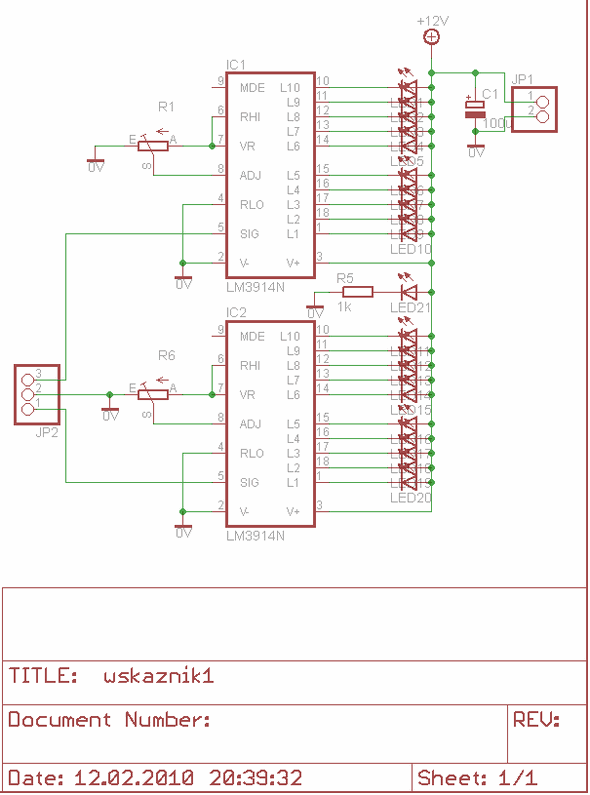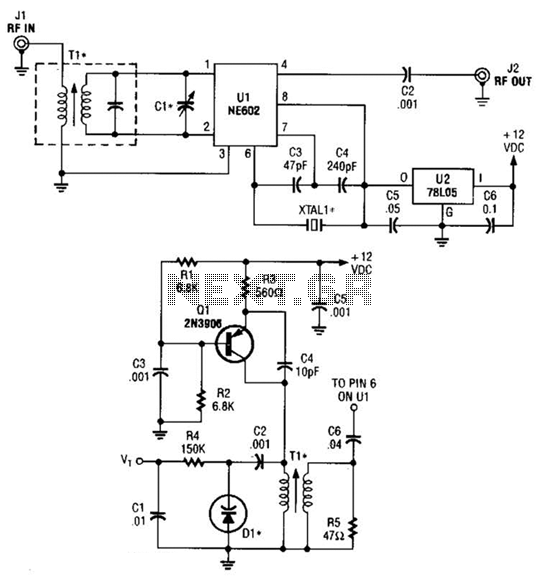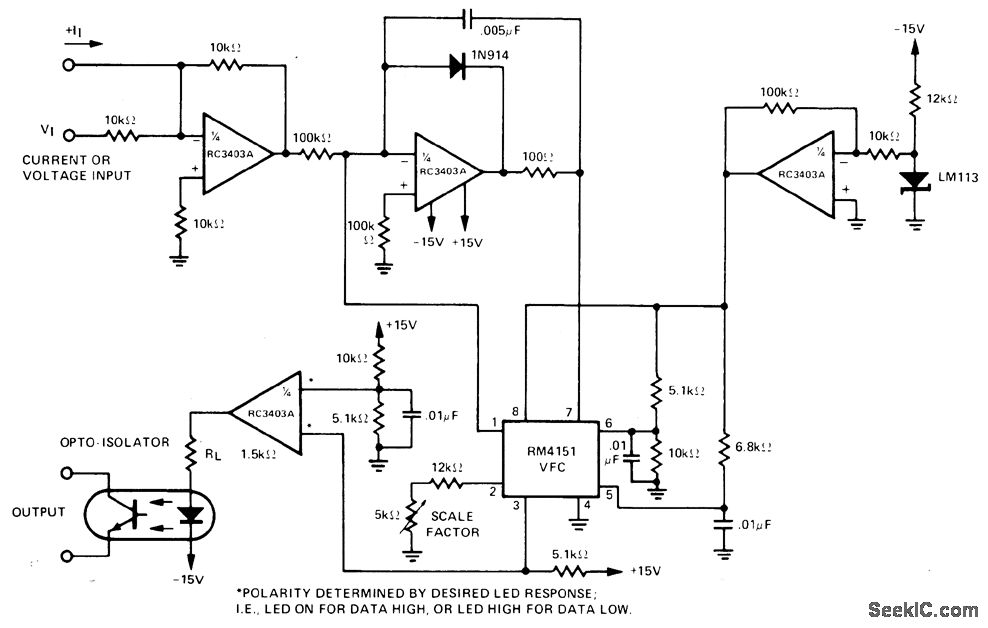
AVR LED RF Field Strength
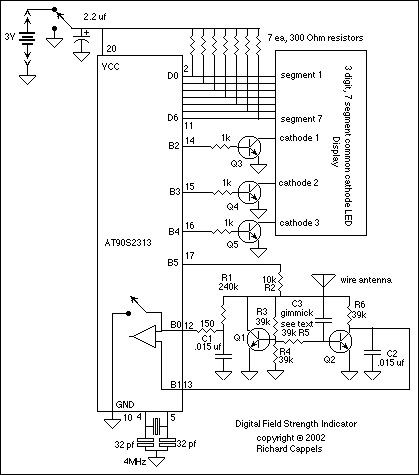
Useful as a transmitter tune-up meter or an RF sniffer, this is an RF field strength indicator that is loosely based on the Broad Band RF Field Strength Probe, described elsewhere. It detects RF via a square law detector, basically it's a crystal set with gain. The bias circuit for the detector is significantly modified from the probe to reduce the effects of battery voltage droop during use. The circuit contains a small analog section and LED driver, tied together by the microcontroller. A two-transistor circuit provides a stabilized voltage and serves as a detector that serves an A-to-D converter based on the comparator contained in the microcontroller. The voltage from the RF detector is measured once every 160 milliseconds and after removing the zero offset, correcting the polarity (higher field strength results in lower voltage from the detector), overflow detection and formatting to BCD, the microcontroller provides drive signals to the three-digit LED display, which is refreshed once every 16 ms, with a dwell time of about 4 ms per character. This is a little slow for a handheld device as when the meter is moved, a trail of digits is left on the user's retina, so if this bothers you, increase the refresh rate. Q1 is a combination shunt regulator and bias source for Q2. As a shunt regulator, it provides a stabilized voltage for the A-D converter circuit. This shunt regulator has low loop gain, thus the display may jitter because this voltage affects the RF detector's output voltage and power supply fluctuations resulting from driving the LEDs may result in feedback that causes the readings to fluctuate. This could be improved by using a band gap reference ahead of the shunt regulator, but it drives cost and complexity up. I have found the circuit to work erratically when using some batteries - these were some very cheap carbon-zinc and (supposedly) Ni-MH cells that were counterfeits of name brands I bought in S.E. Asia. I suspect these cells have a relatively high impedance, though I did not confirm this experimentally. Name-brand (real ones) alkaline and Ni-Cad batteries don't have these problems. The base voltage on Q1 also serves to establish the bias voltage for Q2's base. Q2 serves as an RF detector. Q1 is biased so that there is about 600 millivolts between its collector and emitter. A small wire antenna forms a capacitive coupling from the input of the circuit to the RF source being observed while the bulk of the circuit, including the battery holder forms a capacitive coupling from the circuit's "ground" to "earth". When the user holds the meter in his or her hand, this ground coupling is enhanced. RF from the small wire antenna is capacitively coupled to Q1's base and this modulates the collector in Q1. Gain of the amplifier is independent of the value of the collector resistor (39K in this case) because that's how transistors work (to use vacuum tube terms, collector signal gain is Gm*Rl, and Gm is nearly proportional to collector current, so doubling the collector load cuts Gm in half). The nonlinearity in the base voltage-to-collector voltage transfer function results in the detection of the RF signal. Collector current is averaged by the low pass filter established by the collector current and the capacitance to ground. The other input to the AT90S2313's on-chip voltage comparator is connected to ramp capacitor C1. The time it takes R1 to charge C1 to equal the voltage from the RF detector (on pin 13 of the AT90S2313) is measured to determine the detector's output. See Atmel's application note, AVR400, for the theory of operation for the A-to-D converter. The power switch is SPDT set up to short the +3V line on the circuit to ground to make sure that the decoupling capacitor was completely discharged so the circuit would reset properly if the power was switched off then back on quickly. This was only done as a precaution and is probably not really necessary. Main features: - Wide bandwidth - Digital display with auto zero - Convenient in that it is self-contained - Very low parts count and low cost - Battery-conserving power management
The RF field strength indicator circuit operates primarily by utilizing a square law detection method, which is effective for measuring radio frequency (RF) signals. The design incorporates a microcontroller, specifically the AT90S2313, which manages the overall operation of the device, including the processing of the RF signal and controlling the display output.
The RF detection process begins with a small wire antenna that captures RF signals from the environment. This antenna couples the RF energy to the base of transistor Q1, which is configured as a shunt regulator and bias source for the second transistor, Q2. Q1's operation is crucial as it stabilizes the voltage supplied to the A-D converter within the microcontroller, ensuring accurate measurements of the incoming RF signal.
The circuit's sensitivity to variations in power supply and component tolerances is addressed by the design of Q1, which maintains a specific bias voltage, approximately 600 millivolts between its collector and emitter. This biasing is essential for the proper functioning of Q2, which acts as the primary RF detector. The gain of the circuit is independent of the collector resistor value, allowing for consistent performance despite variations in component values.
The microcontroller periodically samples the output voltage from the RF detector, applying necessary corrections for zero offset and polarity adjustments. The processed data is then formatted into Binary-Coded Decimal (BCD) for display purposes. The LED display refresh rate is set at 16 ms, which may leave a visual trail when the device is in motion, indicating a potential area for improvement in user experience.
To enhance the performance and reliability of the circuit, especially regarding power supply variations, it is recommended to consider using higher quality batteries with lower internal resistance. This will ensure stable voltage levels and reduce fluctuations that may affect the accuracy of readings.
Overall, the RF field strength indicator is designed to be compact, cost-effective, and efficient, making it a valuable tool for RF enthusiasts and professionals alike. Its low parts count and integrated power management features further contribute to its practicality in various applications, including RF tuning and signal detection.Useful as a transmitter tune-up meter or an RF sniffer, this is an RF field strength indicator that is loosely based on the Broad Band RF Field Strength Probe, described elsewhere. It detects RF via a square law detector, basically its a crystal set with gain. The bias circuit for the detector is significantly modified from the probe to reduce the effects of battery voltage droop during use.
The circuit contains a small analog section and LED driver, tied together by the micro controller. A two-transistor circuit provides a stabilized voltage and serves as a detector that serves an A-to-D converter based on the comparator contained in the micro controller. The voltage from the RF detector is measured once every 160 milliseconds and after removing the zero offset, correcting the polarity (higher field strength results in lower voltage from the detector), overflow detection and formatting to BCD, the micro controller provides drive signals to the three digit LED display, which is refreshed once every 16 ms, with a dwell time of about 4 ms per character.This is a little slow for a handheld device as when the meter is moved, a trail of digits is left on the user's retina, so if this bothers you, increase the refresh rate. Q1 is a combination shunt regulator and bias source for Q2. As a shunt regulator, it provides a stabilized voltage for the A-D converter circuit. This shunt regulator has low loop gain, thus the display may jitter because this voltage affects the RF detector's output voltage and power supply fluctuations resulting from driving the LEDs may result in feedback that causes the readings to fluctuate.
This could be improved by using a band gap reference ahead of the shunt regulator, but it drives cost and complexity up. I have found the circuit to work erratically when using some batteries -these were some very cheap carbon-zinc and (supposedly) Ni-MH cells that were counterfeits of name brands I bought in S.E.
Asia. I suspect these cells have a relatively high impedance, thought I did not confirm this experimentally. Name-brand (real ones) alkaline and Ni-Cad batteries don't have these problems. The base voltage on Q1 also serves to establish the bias voltage for Q2's base. Q2 serves a an RF detector. Q1 is biased so that there is about 600 millivolts between its collector and emitter. A small wire antenna forms a capacitive coupling from the input of the circuit to the RF source being observed while the bulk of the circuit, including the battery holder forms a capacitive coupling from the circuits' "ground" to "earth".
When the user holds the meter in his or her hand, this ground coupling is enhanced. RF from the small wire antenna is capacitively coupled to Q1's base and this modulates the collector in Q1. Gain of the amplifier is independent of the value of the collector resistor (39K in this case) because that's how transistors work (to use vacuum tube terms, collector signal gain is Gm*Rl, and Gm is nearly proportional to collector current, so doubling the collector load cuts Gm in half) .The nonlinearity in the base voltage-to-collector voltage transfer funcion results in detection of the RF signal.
Collector current is averaged by the low pass filter established by the collector current and the capacitance to ground. The other input to the AT90S2313s on-chip voltage comparator is connected to ramp capacitor C1. The time it takes R1 to charge C1 to equal the voltage from the RF detector (on pin 13 of the AT90S2313) is measured to determine the detector's output.
See Atmels' application note, AVR400, for the theory of operation for the A-to-D converter. The power switch is SPDT set up to short the +3V line on the circuit to ground to make sure that the decoupling capacitor was completely discharged so the circuit would reset properly if the power was switched off then back on quickly. This was only done as a precaution and is probably not really necessary. Main features: - Wide bandwidth - Digital display with auto zero - Convenient in that it is self contained - Very low parts count and low cost - Battery-conserving power management Follow the links for information on
🔗 External reference
The RF field strength indicator circuit operates primarily by utilizing a square law detection method, which is effective for measuring radio frequency (RF) signals. The design incorporates a microcontroller, specifically the AT90S2313, which manages the overall operation of the device, including the processing of the RF signal and controlling the display output.
The RF detection process begins with a small wire antenna that captures RF signals from the environment. This antenna couples the RF energy to the base of transistor Q1, which is configured as a shunt regulator and bias source for the second transistor, Q2. Q1's operation is crucial as it stabilizes the voltage supplied to the A-D converter within the microcontroller, ensuring accurate measurements of the incoming RF signal.
The circuit's sensitivity to variations in power supply and component tolerances is addressed by the design of Q1, which maintains a specific bias voltage, approximately 600 millivolts between its collector and emitter. This biasing is essential for the proper functioning of Q2, which acts as the primary RF detector. The gain of the circuit is independent of the collector resistor value, allowing for consistent performance despite variations in component values.
The microcontroller periodically samples the output voltage from the RF detector, applying necessary corrections for zero offset and polarity adjustments. The processed data is then formatted into Binary-Coded Decimal (BCD) for display purposes. The LED display refresh rate is set at 16 ms, which may leave a visual trail when the device is in motion, indicating a potential area for improvement in user experience.
To enhance the performance and reliability of the circuit, especially regarding power supply variations, it is recommended to consider using higher quality batteries with lower internal resistance. This will ensure stable voltage levels and reduce fluctuations that may affect the accuracy of readings.
Overall, the RF field strength indicator is designed to be compact, cost-effective, and efficient, making it a valuable tool for RF enthusiasts and professionals alike. Its low parts count and integrated power management features further contribute to its practicality in various applications, including RF tuning and signal detection.Useful as a transmitter tune-up meter or an RF sniffer, this is an RF field strength indicator that is loosely based on the Broad Band RF Field Strength Probe, described elsewhere. It detects RF via a square law detector, basically its a crystal set with gain. The bias circuit for the detector is significantly modified from the probe to reduce the effects of battery voltage droop during use.
The circuit contains a small analog section and LED driver, tied together by the micro controller. A two-transistor circuit provides a stabilized voltage and serves as a detector that serves an A-to-D converter based on the comparator contained in the micro controller. The voltage from the RF detector is measured once every 160 milliseconds and after removing the zero offset, correcting the polarity (higher field strength results in lower voltage from the detector), overflow detection and formatting to BCD, the micro controller provides drive signals to the three digit LED display, which is refreshed once every 16 ms, with a dwell time of about 4 ms per character.This is a little slow for a handheld device as when the meter is moved, a trail of digits is left on the user's retina, so if this bothers you, increase the refresh rate. Q1 is a combination shunt regulator and bias source for Q2. As a shunt regulator, it provides a stabilized voltage for the A-D converter circuit. This shunt regulator has low loop gain, thus the display may jitter because this voltage affects the RF detector's output voltage and power supply fluctuations resulting from driving the LEDs may result in feedback that causes the readings to fluctuate.
This could be improved by using a band gap reference ahead of the shunt regulator, but it drives cost and complexity up. I have found the circuit to work erratically when using some batteries -these were some very cheap carbon-zinc and (supposedly) Ni-MH cells that were counterfeits of name brands I bought in S.E.
Asia. I suspect these cells have a relatively high impedance, thought I did not confirm this experimentally. Name-brand (real ones) alkaline and Ni-Cad batteries don't have these problems. The base voltage on Q1 also serves to establish the bias voltage for Q2's base. Q2 serves a an RF detector. Q1 is biased so that there is about 600 millivolts between its collector and emitter. A small wire antenna forms a capacitive coupling from the input of the circuit to the RF source being observed while the bulk of the circuit, including the battery holder forms a capacitive coupling from the circuits' "ground" to "earth".
When the user holds the meter in his or her hand, this ground coupling is enhanced. RF from the small wire antenna is capacitively coupled to Q1's base and this modulates the collector in Q1. Gain of the amplifier is independent of the value of the collector resistor (39K in this case) because that's how transistors work (to use vacuum tube terms, collector signal gain is Gm*Rl, and Gm is nearly proportional to collector current, so doubling the collector load cuts Gm in half) .The nonlinearity in the base voltage-to-collector voltage transfer funcion results in detection of the RF signal.
Collector current is averaged by the low pass filter established by the collector current and the capacitance to ground. The other input to the AT90S2313s on-chip voltage comparator is connected to ramp capacitor C1. The time it takes R1 to charge C1 to equal the voltage from the RF detector (on pin 13 of the AT90S2313) is measured to determine the detector's output.
See Atmels' application note, AVR400, for the theory of operation for the A-to-D converter. The power switch is SPDT set up to short the +3V line on the circuit to ground to make sure that the decoupling capacitor was completely discharged so the circuit would reset properly if the power was switched off then back on quickly. This was only done as a precaution and is probably not really necessary. Main features: - Wide bandwidth - Digital display with auto zero - Convenient in that it is self contained - Very low parts count and low cost - Battery-conserving power management Follow the links for information on
🔗 External reference
